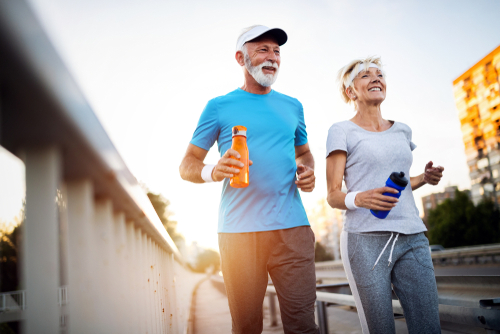
While the fight against COVID-19 is still top of mind for most, we must also be mindful of other health concerns that plague people every day such as mental health, obesity, heart conditions, and even accidental injuries like falls.
As adults age, the risk of falls and resulting serious injury grows exponentially. According to the Centers for Disease Control and Prevention (CDC), 1 out of 4 older Americans experiences a severe fall annually. Additionally, after sustaining an initial fall, risks of subsequent falls increase as well.
Falls are the leading cause of injury in older Americans. These physical traumas can result in broken bones, concussions, expensive hospital stays, and even brain damage that contribute to decreased independence or even death.
Reducing Fall Risk
"Unfortunately, I have treated countless preventable falls,” says Summit Health internist and geriatric medicine specialist Dr. Pouja Ahuja. As adults get older, the risk of falls increases, even with simple tasks. Physiologic changes of aging contribute to loss of muscle mass, joint instability, and impairment of balance. All of these factors contribute to increased incidence of devastating falls. “Falls can occur when you least expect them, so it’s important for all older adults to be careful and take preventative steps," says Dr. Ahuja.
Below is some essential information on why older adults fall more and some must-know fall prevention strategies.
Why Do Older Adults Fall More?
Older adults experience an increased risk of falling for a few reasons, including:
- Vision loss: As we age, our peripheral vision decreases. When an older adult can't see as well, fall hazards can go unnoticed. No matter how physically fit someone is, if they're unable to detect those hazards, they're at a huge disadvantage.
- Disease: Certain diseases play a crucial role in increasing fall risk in the elderly. Some disease processes, including Alzheimer’s disease, Parkinson’s disease, Huntington’s disease, vascular dementia, and arthritis affect a person’s ease of movement.
- Environmental Factors: Fall hazards can be present at home and when in public. Perhaps the most dangerous spot for serious falls is at home. People can fall at home due to poor lighting, clutter, and uneven staircases. The results of a fall at home can be even more devastating if you live alone.
Additionally, people are socializing again, and places are becoming more crowded and noisy. These distractions can be hazardous. Crowded pathways or stairs, where noise is also a distracting factor, can be dangerous places for the elderly.
How to Prevent Falls as an Adult: 3 Prevention Strategies:
Fall prevention strategies are critical for preventing falls and ensuring safety. Please find some tips and resources to help decrease chances of a devastating fall and possible injuries.
Stay Active with Exercise
A sharp decline in physical fitness or physical deconditioning is a leading cause of falls in older adults. If an older adult commits to daily exercise, such as taking a walk every day, their chance of serious falls can decrease.
Maintaining good musculoskeletal health is a great way to improve balance and strengthen muscles, increase flexibility, and build resilience.
While exercising does not entirely negate all risk, it allows older adults to build some physical safeguards that those who don't exercise lack. Some good exercises for older adults to consider include walking, water aerobics, stretching, and even Tai Chi.
Outfit Your Home for Safety
Seemingly innocuous environmental factors can end up becoming an older adult's worst nightmare. “Taking small steps to make your home safe can make a big difference in your comfort level. Installing grab bars in bathrooms, cleaning up clutter – such as loose wires and rugs, and having a well-lit home – can all help you prevent falls,” says Dr. Ahuja.
Get an Eye Exam
Since sight is the best method for perceiving dangers around us, it is crucial to make sure your vision is healthy. Getting an eye exam is a great way to determine if you're at risk for falling and to ensure you are getting the tools you need to improve poor eyesight.
Conditions like cataracts and glaucoma make vision in the elderly a complicated thing. Having a regular eye appointment with your ophthalmologist or optometrist is a good step in preventing and treating chronic eye conditions.
In addition to meeting with your eye doctor, practicing good eye hygiene can make a world of difference.
Using these effective fall prevention strategies can prevent future fractures, brain injuries, and other ill effects from falls.
Summit Health's Geriatric Medicine services offer comprehensive solutions for older adults, equipping them with the tools they need to prevent dangerous falls. Additionally, the geriatric medicine team provides physical therapy, nutrition services, and nursing resources.
Be sure to explore Summit Health's geriatricians for further information and services. To book an appointment, call 908-273-4300.
Let Us Be Your Partner in Well-Being
At Summit Health, we care about our patients’ overall health. There are many reasons you may come in to visit with us, but we want to be sure you get the most out of every appointment. At your next visit, be sure to talk to your provider about appropriate screenings and necessary evaluations. Additionally, if you are having trouble affording your medications, let your provider know. It’s important to have these conversations to stay on top of your health and minimize your risk of developing certain diseases.
Over 65?
Pouja A. Ahuja, DO specializes in preventive care and medical treatment for individuals age 65 and older. She is part of a dedicated and trustworthy interdisciplinary team that includes several advanced practice nurses and care managers to provide coordinated care and greater accessibility for both primary and urgent care needs. Remember to discuss fall risk, bladder health, physical activity expectations, and mental health.
